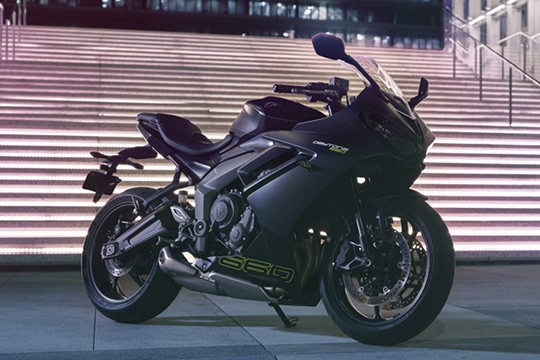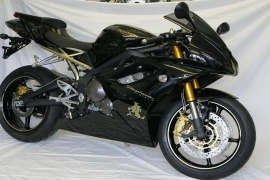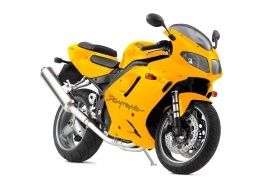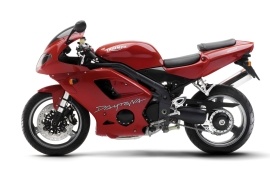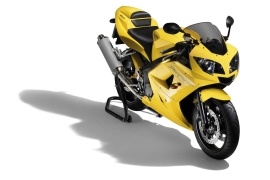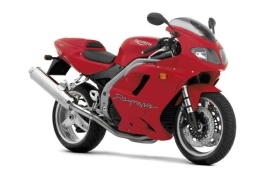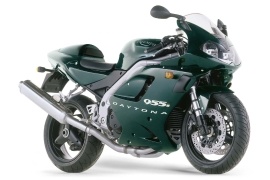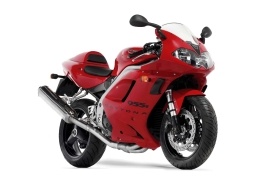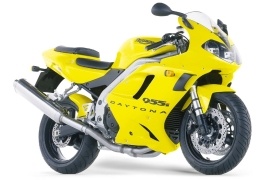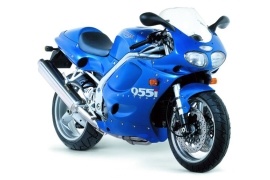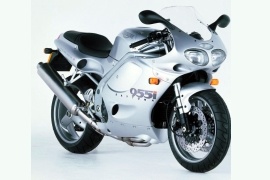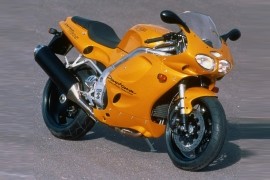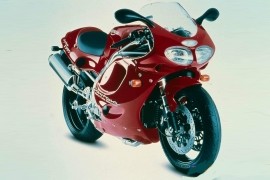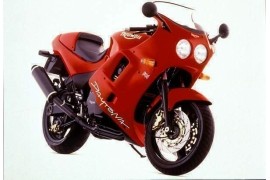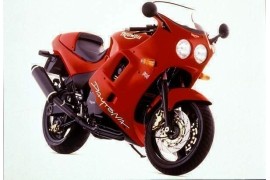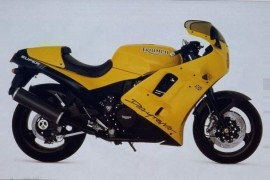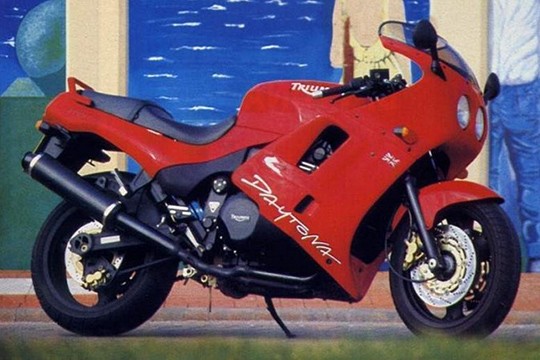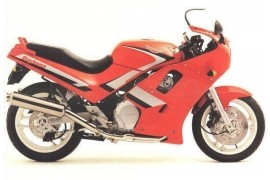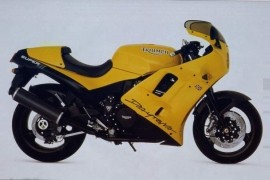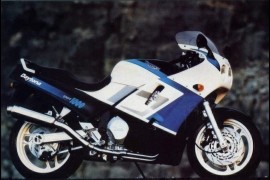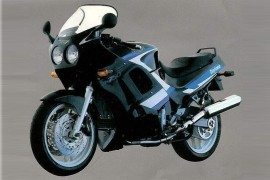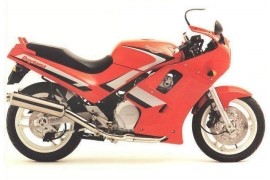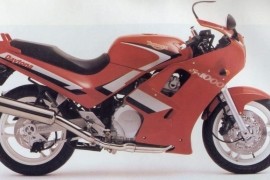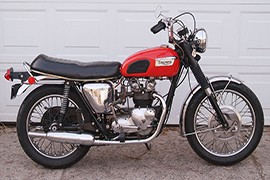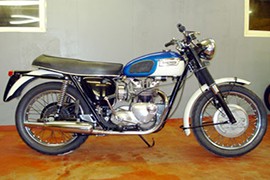TRIUMPH Daytona Models/Series Timeline, Specifications & Photos
First production year: 1967
The British motorcycle manufacturer revealed an all-new triple-powered middleweight sports motorcycle for the 2024 model year under the Daytona 660 designation. The new machine offers thrilling sports performance and a dynamic riding experience, complemented by a high-quality finish, capability, and top-end specifications.
It comes with top-notch technology that enhances the riding experience and safety, such as the ride-by-wire system that offers precise throttle response and three riding modes: Sport, Road, and Rain. Each riding mode adapts to the road conditions, with different throttle responses and levels of traction.
In addition, the traction control system can be turned off using the instrument menu, allowing riders to perform in their own conditions without the help of all electronic aids.
It is built around a tubular steel perimeter frame with a 41 mm Showa inverted telescopic fork on the front that delivers 110 mm of travel and an adjustable Showa shock absorber on the rear with 130 mm of travel.
Enhanced by an Anti-Lock Braking System, the bike's wheels feature two 310 mm floating discs with four-piston calipers on the front and a 220 mm fixed disc with a single-piston caliper on the rear, delivering excellent stopping performance.
As for power, the 2024 Triumph Daytona 660 takes its muscles from a 660cc four-stroke liquid-cooled three-cylinder engine, boasting 95 hp at 11,250 rpm and 69 Nm (51 lb-ft) torque at 8,250 rpm.
The 2024 Triumph Daytona 660 is for sale at an MSRP starting at $9,195.
The Triumph Daytona 675 was a sports motorcycle manufactured in 2006 as a replacement for the Daytona 650 and continued production until 2016, when it was succeeded by the Triumph Daytona 765.
The Daytona 675 was the smallest model in the Triumph triple series and proved to be very light, nimble, powerful, and quick. Also, the bike had great success against the Japanese 600cc competition.
In 2007, the British motorcycle manufacturer launched the Triumph Daytona 675 JPS Limited Edition, a sports motorcycle that featured a JPS-inspired paint scheme. The bike was made in a limited run, counting only five units at $11,100 each. In addition, the bike was available with several Triumph parts and accessories and other components, such as the Prezzo Racing brake and clutch levers.
The bike packed standard features in the visual department, such as a full fairing, a medium windshield, a single seat with lumbar support, an under-seat-mounted exhaust system, and five-spoke lightweight wheels.
Underneath its full fairing, the 2007 Triumph Daytona 675 JPS LE had installed a 675cc four-stroke three-cylinder liquid-cooled engine with a fuel injection system in charge, delivering 123 hp at 12,500 rpm and 73 Nm (54 lb-ft) torque at 11,750 rpm.
With a dry weight of only 166 kg (365 lbs) and a six-speed manual transmission with a wet, multi-plate clutch, the motorcycle reached 255 kph (154 mph).
The Triumph Daytona 995i was a sports motorcycle that debuted in 1997 and continued production until 2006. At first, the bike was released as the Triumph Daytona T595 and later renamed the Daytona 995i.
In 2005, the British motorcycle manufacturer launched the Triumph Daytona 995i, a sports motorcycle in its tenth year of production. Over its production period, the bike received both minor and significant modifications, enhancing its overall capabilities.
The 2005 machine received several modifications, including a revised bodywork with a horizontally-split headlight, a more streamlined fairing, and a reduced tail hump. In addition, the fuel injection system changed from a bypass-regulated-rail to a returnless-rail system, and the frame was finished in black instead of silver.
In the visual department, the motorcycle had standard features, such as a full fairing with a windscreen, a two-piece dual seat, a three-into-one exhaust system, a single silencer mounted on the right side, a single-sided swingarm, and three-spoke aluminum wheels.
Underneath its redesigned fairing, the 2005 Triumph Daytona 955i had installed a 955cc four-stroke three-cylinder liquid-cooled engine with an updated fuel injection system, delivering 149 hp at 10,700 rpm and 100 Nm (74 lb-ft) torque at 8,200 rpm.
With a dry weight of 188kg (414 lbs) and a six-speed manual transmission with a wet multi-plate clutch, the bike reached a top speed of 263 kph (164 mph).
In 2004, the British motorcycle maker released the Triumph Daytona 995i, a sports machine that featured several modifications, including a new cylinder head, a new crankcase, a revised cooling system, a revised gearbox for reduced noise and vibrations, a revised swingarm, and a new Scorched Yellow color.
In other departments, the 2004 motorcycle was identical to the previous model, packing standard features, such as a full fairing with a medium-sized windshield, a two-piece dual seat, a single exhaust system mounted on the right side, a single-sided swingarm, and three-spoke lightweight aluminum wheels.
The bike's backbone was a tubular aluminum frame with a 45 mm fully adjustable telescopic fork on the front and a fully adjustable shock absorber on the rear, delivering excellent suspension performance and handling.
The bike's wheels were fitted with two 320 mm floating discs tied to four-piston calipers on the front and a 220 mm disc with a dual-piston caliper on the rear, offering strong braking performance.
As for the power figures, the 2004 Triumph Daytona 995i had its heartbeat set by a 995cc four-stroke three-cylinder liquid-cooled engine with a fuel injection system in charge, boasting 149 hp with a peak force at 10,700 rpm and 100 Nm (74 lb-ft) torque at 8,200 rpm.
With a dry weight of 188 kg (414 lbs) and a six-speed manual transmission with a wet multi-plate clutch, it reached a top speed of 263 kph (164 mph).
The Triumph Daytona 600 was a fully-faired sports motorcycle manufactured by Triumph Motorcycles Ltd from 2003 to 2005 at the Hinckley factory in Leicestershire, England. The bike was replaced in 2005 by the Triumph Daytona 650.
In 2004, the British motorcycle manufacturer launched the Triumph Daytona 600, a sports machine in its second year of production that didn't bring any significant modifications except for a new color scheme. The new Tornado Red joined the Racing Yellow and Aluminum Silver liveries.
In the visual department, the 2004 machine was identical to the previous model, packing standard fittings, such as a full fairing with a medium-sized windscreen, a two-piece dual seat with an optional passenger seat cover, and three-spoke lightweight aluminum wheels.
The bike was built around an aluminum beam perimeter frame with an aluminum dual-sided swingarm. On the front, it packed a 43 mm cartridge-type fully adjustable fork and an adjustable shock absorber on the rear, offering excellent handling.
In the braking department, the bike's wheels were fitted with two 308 mm discs coupled to four-piston calipers and a 220 mm disc with a single-piston caliper.
As for the power figures, the 2004 Triumph Daytona 600 had its heartbeat set by a 599cc four-stroke four-cylinder liquid-cooled engine with an electronic fuel injection system in charge, delivering 110 hp at 12,750 rpm and 68 Nm (50 lb-ft) torque at 11,000 rpm.
In 2003, the British motorcycle manufacturer launched the Triumph Dayton 955i, a sports motorcycle that debuted in 1997 under the Daytona T595 name. In 1999, the maker changed the name to Daytona 995i and remained in production until 2006.
The 2003 machine came with the same package as the previous model, packing the same technical, visual, and performance specifications without any significant modifications whatsoever.
In the visual department, the Daytona 995i model packed standard features, such as a full fairing with a medium windscreen, a single seat with lumbar support, a pillion seat cover, a three-into-one exhaust system with a silencer mounted on the right side, a single-sided swingarm, and three-spoke aluminum wheels.
In addition, the bike was available with many Triumph accessories, such as high-level, carbon fiber, and stainless steel silencers used off the road only, an alarm system, a tank bag, a luggage rack, a grab rail, frame protectors, a paddock stand, and a front mudguard extension kit.
As for the performance figures, the 2003 Triumph Daytona 995i had its soul brought to life by a 955cc four-stroke three-cylinder liquid-cooled engine with a fuel injection system in charge, boasting 149 hp at 10,700 rpm and 100 Nm (74 lb-ft) torque at 8,200 rpm.
The bike's wheels were fitted with two 320 mm floating discs coupled to four-piston calipers on the front and a 220 mm disc with a dual-piston caliper on the rear wheel, offering strong stopping power.
The Triumph Daytona 600 was a sports motorcycle manufactured by Triumph from 2003 to 2005, when it was replaced by the Triumph Daytona 650. The bike was manufactured at the Hinckley factory in Leicestershire, England.
In the visual department, the bike was fitted with standard features, such as a full fairing with dual headlights, a medium windscreen, a two-piece dual seat with an optional passenger seat cover, a single exhaust system, and three-spoke lightweight aluminum wheels.
The bike was built on a lightweight aluminum beam perimeter frame with a 43 mm fully adjustable telescopic fork on the front and an adjustable shock absorber on the rear, offering excellent suspension performance and handling.
The bike's wheels were fitted with two 308 mm floating discs tied to four-piston calipers on the front and a 220 mm disc with a single-piston caliper on the rear, delivering excellent stopping power.
The 2003 Triumph Daytona 600 had installed underneath its full fairing a 599cc four-stroke four-cylinder liquid-cooled engine managed by an electronically controlled fuel injection system, delivering 112 hp with maximum strength at 12,750 rpm and 68 Nm (50 lb-ft) torque at 11,000.
The bike's power was handled by a six-speed manual transmission with a wet multi-disc clutch linked to the rear wheel through a final X-ring chain drive.
In 2002, the British motorcycle manufacturer launched the Triumph Daytona 995i Centennial Edition, a limited edition machine that packed several notable features and differences from the standard Daytona.
Some notable features included carbon fiber infill panels between the fuel tank and front and rear fairings, a single-sided swingarm, and Aston British Racing Green paint offered only on the 2002 model.
In the visual department, the Centennial Edition version was similar to the standard model, packing a full fairing with a medium windscreen, a single seat with passenger lumbar support, a pillion seat cover, a three-into-one exhaust system with a silencer mounted on the right side, and lightweight three-spoke aluminum wheels.
The bike was built around a tubular aluminum frame with a 45 mm fully adjustable telescopic fork on the front and a fully adjustable shock absorber on the rear, delivering excellent suspension performance and handling.
In the performance department, the 2002 Triumph Daytona 995i Centennial Edition had installed underneath its full fairing a 955cc four-stroke three-cylinder liquid-cooled engine fed by a fuel injection system, delivering 149 hp at 10,700 rpm and 100 Nm (74 lb-ft) torque at 8,200 rpm.
The engine power was transferred to the rear wheel through a six-speed manual transmission with a wet multi-plate clutch and a final X-ring chain drive, pushing the machine to a top speed of 263 kph (164 mph).
The Triumph Daytona 995 was a sports motorcycle manufactured by Triumph from 1997 to 2006. The bike was released in 1997 as the Daytona T595, and due to misunderstandings about the name not revealing the engine capacity, the bike was renamed in 1999 as Daytona 995i.
In 2002, the British motorcycle manufacturer launched the Triumph Daytona 995i, a sports motorcycle that was significantly revised in 2001. The 2003 model received a new Acidic Yellow color, joining the famous Caspian Blue and Aluminum Silver.
In addition, the machine was available with many accessories, including an aftermarket silencer in a carbon or stainless steel finish, a tank bag, sports throw-over panniers, an alarm, an Aero windscreen, carbon fiber side panels, a front mudguard extension kit, and much more.
The bike had standard features in the visual department, such as a full fairing with a medium-sized windscreen, a single seat with lumbar support, a passenger seat cover, a single exhaust system, a single-sided swingarm, and three-spoke lightweight aluminum wheels.
Underneath its full fairing, the 2002 Triumph Daytona 955i had its heartbeat set by a 955cc four-stroke three-cylinder liquid-cooled engine with a fuel injection system feeding the pistons, delivering 149 hp at 10,700 rpm and 100 Nm (74 lb-ft) torque at 8,200 rpm.
The engine power was handled by a six-speed manual transmission with a wet multi-plate clutch and a final X-ring chain drive that spun the rear wheel to a top speed of 263 kph (164 mph).
In 2001, the British motorcycle maker released the Triumph Daytona 955i, a sports motorcycle that featured significant design and performance modifications that enhanced its look, performance, and handling.
The 2001 model came with a complete redesign of the bodywork, designed by Gareth Davies, and a new engine with more power and torque due to internal modifications, such as a forged steel crankshaft, forged aluminum pistons, and forged steel connecting rods.
Also, the engineers focused on weight saving and better handling, fitting the machine with a dual-sided swingarm instead of the single-sided unit previously used, saving 3.4 kg (7.5 lbs) and offering better handling due to less flex in the swingarm.
In the visual department, the 2001 Daytona 955i packed a full dress with a single headlight instead of the twin unit previously used, a fixed windscreen, a two-piece dual seat, a three-into-one exhaust system, and lightweight three-spoke aluminum wheels.
Underneath its armor, the 2001 Triumph Daytona 995i had installed a 955cc four-stroke three-cylinder liquid-cooled engine with a fuel injection system in charge, boasting 149 hp with a peak force at 10,700 rpm and 100 Nm (74 lb-ft) torque at 8,200 rpm.
In the suspension department, the machine packed a 45 mm fully adjustable telescopic fork on the front and a fully adjustable shock absorber on the rear, offering excellent handling capabilities.
In 2000, the British motorcycle manufacturer launched the Triumph Daytona 955i, a sports motorcycle made by Triumph from 1997. The bike was in its fourth year of production and featured only minor technical modifications.
In 2000, the only modification brought to the table was a more compact and advanced Sagem MC1000 engine management system with two plugs, instead of the original MC2000 that featured only one plug.
In the aesthetic department, the machine had standard features, such as a full bodywork with a twin headlight system, a medium-sized windscreen, a two-piece dual seat with an optional passenger seat cover, a three-into-one exhaust system, a single-sided swingarm, and three-spoke lightweight aluminum wheels.
In the performance department, the 2000 Triumph Daytona 955i had its soul brought to life by a 995cc four-stroke three-cylinder liquid-cooled engine with a fuel injection system in charge, boasting 130 hp at 9,900 rpm and 100 Nm (74 lb-ft) torque at 7,600 rpm.
The engine was tied to a six-speed manual transmission with a wet multi-plate clutch and a final X-ring chain drive, which spun the rear wheel to a top speed of 270 kph (167 mph).
From top speed to a complete stop, the bike relied on two 320 mm floating discs tied to four-piston calipers on the front wheel and a 220 mm disc with a dual-piston caliper on the rear wheel, delivering excellent stopping power.
The Triumph Daytona was a sports bike made by the British company from 1997 to 2006. Despite its name, the bike packed a 995cc three-cylinder engine and was renamed in 1999 as the Triumph Daytona 995i, indicating engine displacement and fueling.
In 1999, the British maker released the Triumph Daytona 955i, a sports machine that debuted in 1997. It received several modifications, including new throttle bodies, injectors, fuel rail, and a new frame.
The bike was built on a tubular aluminum frame, using the powerplant as a stressed member. On the front, it packed a 45 mm cartridge-type adjustable telescopic fork and an adjustable shock absorber on the rear, providing excellent suspension performance and handling capabilities.
The bike's wheels were equipped with two 320 mm floating discs tied to four-piston calipers on the front and a 220 mm disc with a dual-piston caliper on the rear, providing excellent braking performance.
Underneath its fuel tank, the 1999 Triumph Daytona 955i packed a 955cc four-stroke three-cylinder liquid-cooled engine with a multipoint sequential electronic fuel injection system in charge, delivering 130 hp at 9,900 rpm and 100 Nm (74 lb-ft) torque at 7,600 rpm.
The engine power was handled by a six-speed manual transmission with a wet multi-plate clutch linked to the rear wheel through a final O-ring chain drive, pushing the motorcycle to 270 kph (167 mph).
In 1998, the British motorcycle manufacturer launched the Triumph Daytona T595, a sports motorcycle that debuted in 1997. Despite its name, the bike packed a 995cc three-cylinder engine. In 1999, the bike was renamed as Daytona 955i.
The Daytona T595 was addressed to those riders who wanted a superbike but still desired a British-made badge that exhaled dependability and durability. Even though the bike delivered lower power figures than its competitors, the British engineers crafted a beautiful machine with an aggressive look and British class.
The bike packed the same standard features as the previous model in the visual department, including a full dress with two roundish headlights, a medium-sized windscreen, a two-piece dual seat, a three-into-one exhaust system, and three-spoke lightweight aluminum wheels.
The bike's backbone was a lightweight aluminum perimeter frame with a 45 mm adjustable Showa telescopic fork on the front and an adjustable Showa shock absorber on the rear, providing excellent handling capabilities.
The bike's wheels were fitted with two 320 mm discs tied to four-piston calipers on the front and a 220 mm disc squeezed by a dual-piston caliper on the rear, offering excellent stopping power.
In the performance department, the 1998 Triumph Daytona T595 had installed underneath its full dress a 995cc four-stroke three-cylinder liquid-cooled fuel-injected engine that delivered 130 hp at 10,200 rpm and 100 Nm (74 lb-ft) torque at 8,300 rpm, pushing the motorcycle to 254 kph (158 mph).
The Triumph Daytona T595 was a sports motorcycle manufactured by the British company from 1997 to 2006, with a 955cc engine in charge. The bike was released in 1997 as the Daytona T595 and renamed in 1999 as the Triumph Daytona 995i.
In 19997, the British motorcycle maker introduced the Triumph Daytona T595, a sports machine intended to join the sports market. Although the bike was named T595, it packed a 995cc three-cylinder engine designed in collaboration with Lotus.
In the aesthetic department, the bike had standard features, such as a full fairing with a medium-sized windscreen, a single seat with a passenger seat cover, a three-into-one exhaust system with a silencer mounted on the right side, and a three-spoke lightweight aluminum wheels.
The bike was built on a lightweight aluminum perimeter frame with a 45 mm adjustable Showa telescopic fork on the front and an adjustable Showa shock absorber on the rear, delivering excellent suspension performance and handling.
As for the braking performance, the bike packed two 320 mm discs with four-piston calipers on the front wheel and a 220 mm disc with a dual-piston caliper on the rear wheel, offering excellent stopping power.
Underneath its fuel tank, the 1997 Triumph Daytona T595 had installed a 955cc four-stroke three-cylinder liquid-cooled engine managed by a fuel injection system, boasting 130 hp at 10,200 rpm and 100 Nm (74 lb-ft) torque at 8,300 rpm.
The Triumph Daytona was a sports motorcycle made by Triumph Motorcycles Ltd at the Hinckley factory in Leicestershire, England. The bike was part of the Daytona series that comprised several machines made from 1991 to 1998 with different engine displacements.
The 1990 Cologne Motorcycle Show presented the Daytona model in four configurations: 750cc and 900cc with a three-cylinder engine, 1,000cc and 1,200cc with a four-cylinder unit.
In 1993, the 750cc engine was replaced with an 885cc three-cylinder unit already running on the Trident and Trophy series. The Daytona range used a modular liquid-cooled DOHC engine strapped in a high-tensile tubular steel frame.
In 1996, the British motorcycle manufacturer launched the Triumph Daytona 900 Super III, a sports machine in its fourth production year, packing the same performance, technical, and visual specifications as previous models, without any modifications whatsoever.
The bike packed a full fairing with two round headlights, a medium-sized windscreen, a single seat with lumbar support, a passenger seat cover, a dual exhaust system with a muffler on each side, and three-spoke lightweight aluminum wheels.
The 1996 Triumph Daytona 900 Super III had installed underneath its dress an 885cc four-stroke three-cylinder liquid-cooled engine with three Mikuni carburetors in charge, delivering 114 hp at 9,500 rpm and 87 Nm (64 lb-ft) torque with maximum strength at 6,500 rpm.
In 1995, the British motorcycle maker launched the Triumph Daytona 900 Super III, a sports motorcycle that debuted in 1993. The bike was derived from the Daytona 750 model and featured a larger engine with more power and torque.
The bike was in its third year of production and came with the same technical, visual, and performance specifications as previous models, without any significant modifications. The same 885cc three-cylinder engine was used on the Trident and Trophy range.
Compared to the Daytona 750 model, the 900 Super III version had an edgier look, with standard features, such as a medium-sized windscreen, two round headlights, a full fairing, a single seat with lumbar support, a pillion seat cover, a three-into-two exhaust system, and lightweight three-spoke aluminum wheels.
As for power, the 1995 Triumph Daytona 900 Super III had installed underneath its fuel tank an 885cc four-stroke three-cylinder liquid-cooled engine with three Mikuni carburetors in charge, boasting 114 hp at 9,500 rpm and 87 Nm (64 lb-ft) torque at 6,500 rpm.
The bike's backbone was a twin-spar aluminum frame with a 43 mm fully adjustable telescopic fork on the front and an adjustable shock absorber on the rear, providing excellent handling capabilities.
As for the braking performance, the bike's wheels were fitted with two 310 mm discs with six-piston calipers on the front and a 255 mm disc with a dual-piston caliper on the rear, offering excellent stopping power.
The Triumph Daytona and Daytona Super 3 was a series of sports motorcycles manufactured by Triumph at the Hinckley factory in Leicestershire, England, from 1991 to 1998, except for 1997, when the bike was not produced.
The Triumph Daytona was offered in two versions. One was a 749cc version with a three-cylinder engine, and the other was a 998cc four-cylinder model. In 1993, the Triumph Daytona 750 featured a significant change, dropping the 750cc engine in favor of a larger 885cc version with more power and torque.
In 1994, the British motorcycle manufacturer launched the Triumph Daytona 900 Super III, a sports machine that replaced the Triumph Daytona 750. The bike retained the same proven chassis shared with many other Triumph models.
In the visual department, the bike had an edgier look, packing standard features, such as a full fairing with two round headlights, a medium-sized windscreen, a single seat with lumbar support, a passenger seat cover, a dual exhaust system with a silencer on each side, a lightweight aluminum wheels.
The 1994 Triumph Daytona 900 Super III had installed underneath its dress an 885 cc four-stroke three-cylinder liquid-cooled powerplant managed by three Mikuni carburetors. The engine produced 114 hp with maximum strength at 9,500 rpm and 87 Nm (64 lb-ft) torque at 6,500 rpm.
The Triumph Daytona was a sports motorcycle made by Triumph from 1991 to 1996 at the Hinckley factory in Leicestershire, England. The range comprised three-cylinder and four-cylinder powered motorcycles.
In 1993, the British motorcycle manufacturer launched the Triumph Daytona 1200, a sports motorcycle that packed a tuned version of the 1,180cc four-cylinder engine used by the Triumph Trophy 1200.
In the aesthetic department, the bike packed standard features, such as a twin round headlight unit, a medium-sized windscreen, a full fairing, a one-piece dual seat with a passenger grab rail, a dual exhaust system with a muffler on each side, a side stand, and three-spoke lightweight aluminum wheels.
In the suspension department, the bike packed a 43 mm telescopic fork on the front and a single shock absorber on the rear, providing optimum suspension performance and handling capabilities.
As for the braking power, the bike's wheels were fitted with two 310 mm discs tied to four-piston calipers on the front and a 255 mm disc coupled to a dual-piston caliper on the rear, offering excellent stopping power.
Underneath its full fairing, the Triumph Daytona 1200 had hidden from plain sight a 1,180cc four-stroke four-cylinder liquid-cooled engine fed by four carburetors, delivering an output power of 147 hp at 9,400 rpm and 115 Nm (85 lb-ft) torque at 8,000 rpm.
In 1993, the British motorcycle manufacturer launched the Triumph Daytona 750, a sports motorcycle that debuted in 1991 and continued production until 1998 without any significant modifications.
The bike was manufactured by Triumph Motorcycles Ltd at the Hinckley factory in Leicestershire, England, the business successor of Triumph Engineering at Meriden Works, Warwickshire, England. The bike was also offered in a 998cc four-cylinder version.
The bike's appearance was similar to its predecessors, with standard features, such as a full fairing, two round headlights, a one-piece dual seat with a passenger grab handle, a dual exhaust system with a silencer on each side, and lightweight aluminum wheels.
Underneath its dress, the 1993 Triumph Daytona 750 had installed a 749cc four-stroke three-cylinder liquid-cooled engine with three carburetors feeding the pistons, delivering 97 hp at 8,750 rpm and 66 Nm (49 lb-ft) torque at 8,500 rpm.
The bike's suspension system comprised a 43 mm adjustable telescopic fork on the front and a tri-link adjustable shock absorber on the rear, providing excellent handling capabilities.
As for the braking power, the bike's wheels were fitted with two 296 mm discs with four-piston calipers on the front and a 255 mm disc with a dual-piston caliper on the rear wheel, offering excellent stopping power.
Also, in 1993, the 749cc engine was dropped from production and replaced with an 855cc triple engine already running on the Trident and Trophy series.
The Triumph Daytona was a sports motorcycle manufactured by Triumph from 1991 to 1998, except for 1997, when the bike was not produced. The bikes were manufactured at the Hinckley manufacturing plant in Leicestershire, England.
The Daytona machine was offered in a 749cc three-cylinder version and an 885cc four-cylinder model. The Triumph Daytona 750 was manufactured until 1993 when its engine was replaced by an 885cc three-cylinder unit with more power and torque.
In 1993, the British motorcycle manufacturer launched the Triumph Daytona 900 Super III, with a new engine underneath its fairing. The 885cc unit was already used by the Trident and Trophy series.
In the visual department, the bike was similar to its predecessor, packing standard features, such as a full fairing with a medium-sized windscreen, two round headlights, a single seat with small lumbar support and a passenger seat cover, lightweight aluminum wheels, and a dual exhaust system with a muffler on each side.
The 1993 Triumph Daytona 900 Super III had installed underneath its fuel tank an 885cc four-stroke liquid-cooled three-cylinder engine with three carburetors in charge, boasting 114 hp at 9,500 rpm and 87 Nm (64 lb-ft) torque at 6,500 rpm.
The bike was built around a twin-spar aluminum frame with a 43 mm adjustable telescopic fork on the front and an adjustable shock absorber on the rear, delivering excellent suspension performance and handling capabilities.
In 1992, the British motorcycle manufacturer launched the Triumph Daytona 1000, a sports machine that debuted in 1991 and featured the same technical, visual, and performance specifications as the previous model.
The 1992 machine featured the same package as its predecessor, with standard features, such as a full fairing, two round headlights, a medium-sized windscreen, a one-piece dual seat with a passenger grab rail, a dual exhaust system, and three-spoke lightweight aluminum wheels.
Underneath its fuel tank, the 1992 Triumph Daytona 1000 had installed a 998cc four-stroke four-cylinder liquid-cooled engine with three carburetors in charge, delivering an output power of 120 hp with a peak force at 10,500 rpm and 88 Nm (65 lb-ft) torque at 8,500 rpm.
All the power produced by the engine was transferred to a six-speed manual transmission with a wet multi-disc clutch and a final chain drive, pushing the motorcycle to a top speed of 239 kph (149 mph).
The bike was built on a twin-spar steel frame with a 43 mm adjustable telescopic fork on the front and an adjustable shock absorber on the rear, offering excellent suspension performance and handling.
As for the braking power, the bike's wheels were fitted with two 310 mm discs paired with four-piston calipers on the front and a 255 mm disc with a dual-piston caliper on the rear, delivering excellent stopping power.
The Triumph Daytona was a sports motorcycle manufactured by Triumph from 1991 to 1996 at the Hinckley plant in Leicestershire, England. In addition to the 749cc three-cylinder version, the maker made a 998cc four-cylinder model available along with two other machines with 900cc and 1,200cc powerplants.
In 1992, the British motorcycle manufacturer launched the Triumph Daytona 750, a sports machine in its second year of production, packing the same visual, technical, and performance specifications as the previous model.
In the aesthetic department, the bike had standard features, such as a full fairing with two round headlights, a medium-sized windscreen, a one-piece dual seat with a passenger grab handle, a dual exhaust system with a silencer on each side, and three-spoke lightweight aluminum wheels.
In the suspension department, the bike packed a 43 mm adjustable telescopic fork on the front and an adjustable shock absorber on the rear, providing excellent suspension performance and handling.
The bike's wheels were fitted with two 296 mm discs coupled to four-piston calipers on the front and a 255 mm disc with a dual-piston caliper on the rear, delivering excellent stopping power.
As for the power figures, the 1992 Triumph Daytona 750 had installed underneath its dress a 749cc four-stroke three-cylinder liquid-cooled engine fed by three BST CV carburetors, boasting 97 hp with maximum strength at 8,750 rpm and 66 Nm (49 lb-ft) torque at 8,500 rpm.
The Triumph Daytona was a sports motorcycle made at the Hinckley plant in Leicestershire, England, from 1991 to 1996 by Triumph Motorcycle Ltd, the business successor of Triumph Engineering at Meriden Works, Warwickshire, England.
The bike was initially offered with a 749cc three-cylinder engine or a 998cc four-cylinder unit. Both machines had similar appearances and delivered excellent wind protection and a relaxed riding position.
In 1991, the British motorcycle manufacturer launched the Triumph Daytona 750, a sports machine that had standard features, such as a full fairing with two round headlights, a medium-sized windscreen, a one-piece seat with a passenger grab rail, a dual exhaust system, and three-spoke lightweight aluminum wheels.
Underneath its full dress, the 1991 Triumph Daytona 750 had installed a 749cc four-stroke three-cylinder liquid-cooled engine fed by three carburetors, delivering 97 hp at 8,750 rpm and 66 Nm (49 lb-ft) torque at 8,500 rpm.
The power produced by the engine was transferred to a six-speed manual transmission with a wet multi-disc clutch, spinning the rear wheel through a final chain drive.
The bike's suspension system comprised a 43 mm adjustable telescopic fork on the front and an adjustable shock absorber on the rear, delivering excellent suspension performance and handling.
As for the braking power, the bike's wheels were fitted with two 296 mm discs and four-piston calipers on the front and a 255 mm disc with a dual-piston caliper on the rear, providing excellent stopping power.
The Triumph Daytona was a sports motorcycle made by Triumph from 1991 to 1996. The bike was available with two engine versions: a 749cc three-cylinder unit and a four-cylinder 998cc version.
The bike was manufactured at the Hinckley factory in Leicestershire, England, by Triumph Motorcycles Ltd, the business successor to Triumph Engineering at Meriden Works, Warwickshire, England.
In 1991, the British motorcycle manufacturer launched the Triumph Daytona 1000, a sports motorcycle that had standard features, such as a full fairing, two-round headlights, a medium-sized windscreen, a one-piece dual seat with a passenger grab handle, a dual exhaust system with a silencer on each side, and three-spoke lightweight aluminum wheels.
Underneath its fairing, the 1991 Triumph Daytona 1000 had hidden from plain sight a 998cc four-stroke four-cylinder liquid-cooled engine fed by four Mikuni carburetors, delivering 120 hp at 10,500 rpm and 88 Nm (65 lb-ft) torque at 8,500 rpm.
The engine power was transferred to a six-speed manual transmission with a wet multi-disc clutch and a final chain drive that spun the rear wheel to a top speed of 239 kph (149 mph).
The bike was built around a steel twin-spar frame with a 43 mm adjustable telescopic fork on the front and an adjustable shock absorber on the rear, delivering excellent suspension performance and handling.
The Triumph Daytona T100R is essentially the high-performance version of the T100C Trophy 500 twin. Fitted with a new alloy cylinder head mounting two Amal Monobloc carubretors ‘Bonneville-style’, it also had higher compression and hotter cams.
The Triumph Tiger Daytona, also known as the T100T, was a motorcycle manufactured by Triumph from 1967 to 1974. The bike's name was derived from the American rider Buddy Elmore's 1996 Daytona 200 race win. The race was held at the Daytona International Speedway in Daytona Beach, Florida.
The bike was based on the setup developed for the 1966 Daytona races, being fitted with a new cylinder head and two Amal Monobloc carburetors. Later models were upgraded with special race profile cams for intake and exhausts, valve guides, and performance connecting rods.
In the visual department, the bike featured a simple design and was fitted with standard features, such as a round headlight at the front, a one-piece dual seat, a dual-exhaust system, a side stand, and wire-poke wheels.
Underneath its fuel tank, the 1967 Triumph Daytona T100T had installed a 490cc four-stroke parallel-twin air-cooled engine managed by two Amal carburetors, delivering an output power of 41 hp with a maximum peak force at 7,400 rpm.
The bike packed a telescopic fork with a drum braking unit on the front and side-mounted shock absorbers with a drum unit on the rear, providing optimum suspension performance, handling, and stopping power.
The bike was slower than the Norton 500 Dominator but instead was a very popular and reliable machine.
